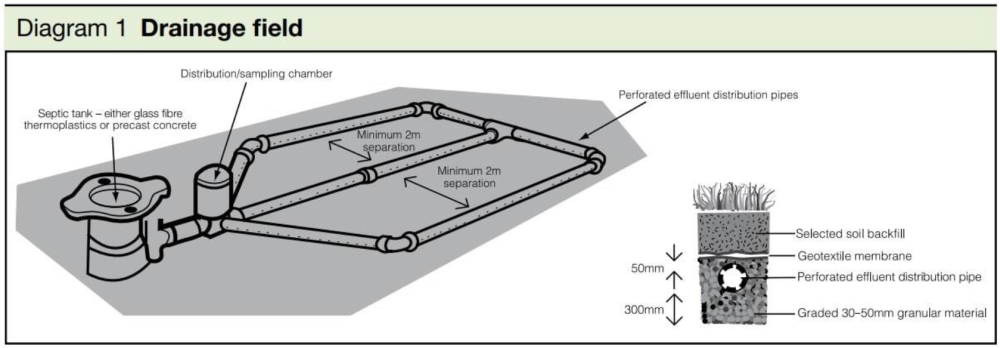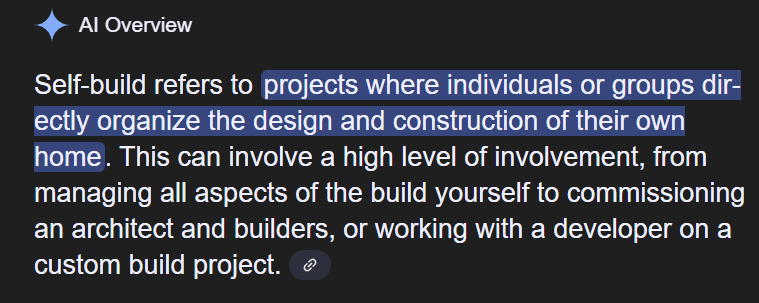-
Posts
1831 -
Joined
-
Days Won
6
Everything posted by IanR
-

PHPP modelling
IanR replied to allthatpebbledash's topic in Energy Efficient & Sustainable Design Concepts
Dr. Rod Williams (Williams Energy Design): https://mango-projects.co.uk/2020/05/28/who-are-mango-projects-ltd/ https://passivhaus.uk/directory/williams-energy-design/ Rod helped me out on mine and was very good. -

Power floated slab. Now rethinking micro-cement
IanR replied to flanagaj's topic in General Flooring
Not me either. I did look at it, but went with poured resin directly on the power-floated RC slab. -

Help to understand a planning condition please
IanR replied to PStirlo's topic in Planning Permission
Yes, that is an ancillary use. You can't add a kitchen and bathroom to make it habitable, independent from the main dwelling. -

Building Two houses
IanR replied to Big Jimbo's topic in Self Build VAT, Community Infrastructure Levy (CIL), S106 & Tax
Yep, should be. You'd be wise to collect evidence of it being your principle residence, ie. registered for Bank, NHS, Council Tax, Utilities at the appropriate address, at the correct times. -

Building Two houses
IanR replied to Big Jimbo's topic in Self Build VAT, Community Infrastructure Levy (CIL), S106 & Tax
Married couples "only" get Private Residence Relief on CGT, on one property (unless you are Angela Rayner). So, depends what you plan to do with the second new-build in your wife's name. If you can apply PRR to the property in your name, any profit you make should be tax free, until Labour change the rules. -
You'd need to apply for an S73, variation of conditions, and try to get that condition either removed or reduced from the original planning application. There is a push for LPA's to use Conditions less than they have done in the passed, and old conditions are getting easier to change, especially if they are unrequired today. But, to be successfully, you have to argue that in some way the condition fails to meet at least one of the following 6 tests: Necessary Relevant to planning Relevant to the development permitted Enforceable Precise Reasonable in all other respects Definitely one for a planning consultant. Search for S73 applications on the local planning portal, and try to find a consultant that has successfully achieved similar. It would be worth spending a few hours of time for someone to review the specifics of your planning condition and advise if you would likely be successful.
-
No, PD only covers use incidental to the main dwelling, which means the building can not be capable of being an independent living space. Normally, the Council will act on a complaint and then give the owner a chance to normalise the situation by submitting retrospective planning. If the planning then fails the building would need to be modified to something acceptable (or meets PD), or removed.
-

Self build house - is MVHR worth cost?
IanR replied to Wadrian's topic in Mechanical Ventilation with Heat Recovery (MVHR)
But, a house that has uncontrolled (natural) ventilation above 3m³/m².h@50Pa is deemed to have sufficient ventilation (when combined with trickle vents and wet room extractors). That leakage is unfiltered and without an option to recover energy from. Any additional ventilation brought in by an MVHR system is unrequired, so while it may be filtered and have 85% of the energy recovered from it, it is additional, unrequired ventilation and therefore adds to the energy losses and dust/pollen/pollutants (that make it through the filters) within the house. It's having better air tightness that stops the uncontrolled leakage of warm air and ingress of dust/pollen etc. and then provides the option of heat recovery and filtration. -

Self build house - is MVHR worth cost?
IanR replied to Wadrian's topic in Mechanical Ventilation with Heat Recovery (MVHR)
MVHR doesn't bring benefit in itself, but it facilitates air tightness better than 3m³/m².h@50Pa. Good air tightness brings comfort and energy cost benefits and allows you to then filter the required ventilation to remove duct and pollen. For air tightness greater than 3m³/m².h@50Pa you must have whole house mechanical ventilation. -
Muckaway should be less for a raft. Depends. There's no reason for it to be more expensive, in fact it should be cheaper when you compare like-for-like, including performance and include the screed you need on a traditional foundation but don't require on a raft. However, insulated rafts remain niche in the UK and you need to do your own ground works (or hire your own team) otherwise you will be paying a premium for labour, concrete, steel etc. from a company that packages it all up for you. A previous discussion:
-

Connectivity Plan - Approved Document R
IanR replied to Caroline's topic in General Self Build & DIY Discussion
If you have "Superfast" then I assume you have a temporary location for the Network provider's ONT box, perhaps on the mobile home side, or a kiosk. If that's the case you need to contact your ISP and ask for an "ONT shift". This is chargeable, so they should arrange for the Network Provider (OpenReach etc.) to come and survey and quote them for the work, which the ISP should then advise you the cost of. You may not get much detail of the works to be completed, but a cost from the ISP for an ONT shift, will confirm to BC that the new poperty will have FTTP. BC are then also asking for you for a schematic that high-lights the ONT position in the new property, they'll want to see provision for any ducting required to get to that position, a power outlet in the close viscinity and your network distribution (Router and Switch) close by. -
Bring down the lower edge of the cladding to the top of the ground floor windows, so you can put the top boxes for the ground floor blinds behind the cladding also: +1 for external blinds with automated shading control.
-
I'm not sure what you mean by "infiltration tunnels" is it a specific product? However, it's not a Council decision, it's a National requirement. If you are going to have a private sewage system in England then you as the operator have to either meet the General Binding Rules or get a permit from the EA. Building Control should require you to do one or the other as per your local council. As the "Operator" of an STP without a permit, you are criminally liable for the STP meeting the GBR's. The wording as been softened in the 2023 version of GBR's to now say they will only bring a criminal prosecution if your STP causes pollution AND you do not meet the GBR's. If the "infiltration tunnels" can be used to construct a drainage field and meet BS 6297:2007, there should be no problem. Edited to add a relevant previous post:
-
It's not unfortunately, in codifying the requirement natural options have disappeared for perforated tubes with their fixed cross-section and calculable flow-rates, so something more like Still relatively simple, but a second chamber is required for an STP, the first being a settlement chamber to seperate the solids (that needs emptying every 1 - 2 years), then the aerated liquid chamber with a filter media.
-
That's a misunderstanding. While the discharge has low toxicity, if it is allowed to build up it can get to a hazardous level, so the GBR's require their discharge to be controlled either into a drainage field or a water course.
-
Then to meet the General Bing Rules you'll need a Drainage Field that meets BS 6297:2007 I'm not sure if that document is available free of Charge, but if you ask Gemini, it gives you a good idea of what is required: Edited to add what looks like a good reference to clear up any confusion on what a Drainage Field is: https://www.homeseptic.co.uk/drainage-field-size-calculation-and-design/
-
If your site is in England you must meet the General Binding Rules, otherwise you require a permit from the Environmental Agency. The GBR is the far easier route. For a new discharge you can not use a soakaway, for discharges to ground it must be via a drainage field. Both STP and Drainage filed must be in line with the relevant British Standard. See Rule 9 for the specifics Ref. https://www.gov.uk/guidance/general-binding-rules-small-sewage-discharge-to-the-ground Lots of rules, make sure you meet all of them. Under the GBR you can discharge to a Water Course in some circumstances, so when you say "cannot discharge to a water course" I assume you mean you do not have access to a suitable water course.
-
Essex Highways require gates to be a minimum 6m from the highway to avoid a vehicle stopping on the highway in order to open the gates. Footpaths are part of the highway.
-
100mm PIR would bring the 9" solid brick wall down to 0.25 U Value from around 1.9 The ubakus site allows you to try different build ups, although uses German products. https://www.ubakus.de/ Of more a concern through would be ensuring moisture can get out of the wall. How old are the walls? Is there a damp proof course?
-
For some PU resins, voc's would be released during the curing process, once cured there is no further off-gassing whether or not heat is applied. That statement doesn't cover all PU foams where a foaming agent is used. Good ventilation is recommended during the 5 days of curing. There are also low-voc and zero-voc options that reduce off-gassing during the curing phase. Wouldn't that be epoxy based for cement repairs, or are you referring to a PU sealant to fill cracks? Epoxy resins do continue to off-gas after curing, although at a much lower rate than during curing.
-
-
That's a complete misunderstanding of the product.
-
Hi and Welcome. SIPs = don't do it, go for a twin wall or I Joist structure and cellulose blown insulation MVHR = great benefits, but only if combined with a < 1.5m³/m².h @ 50Pa infiltration rate. UFH = no regrets Best Flooring = Hmm, subjective one, but combined with UFH I'd suggest PU poured Resin. Good Luck!
-
"DWG" is the native format to Autocad, so if the house plans were authored in Autocad the DWG may include templates, macros, metadata etc. that the Architect feels is their intellectural property and may not wish to hand that information over. But, DWG can also be a neutral file format exported from other CAD systems and contain only the Vector image of the house plans that you see when you print them out. Depending on what "he" intends to do with them, a vector PDF will/can provide the same info as a neutral file DWG.
-
No harm in requesting, but likely the best you can expect is a vector based PDF. Some architect's seem to get prickly about handing over their native CAD files, unless you have agreed it prior. This is defintely one to agree up front. "CAD" means different things to different people, what are you hoping to do with the file(s), a vector PDF may well be sufficient.






